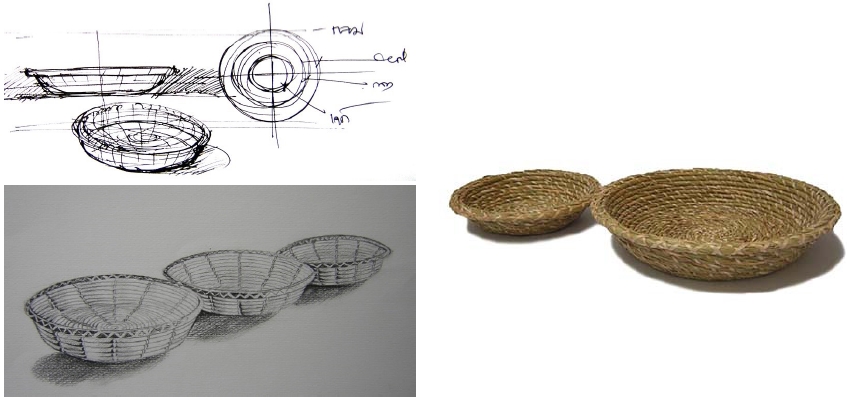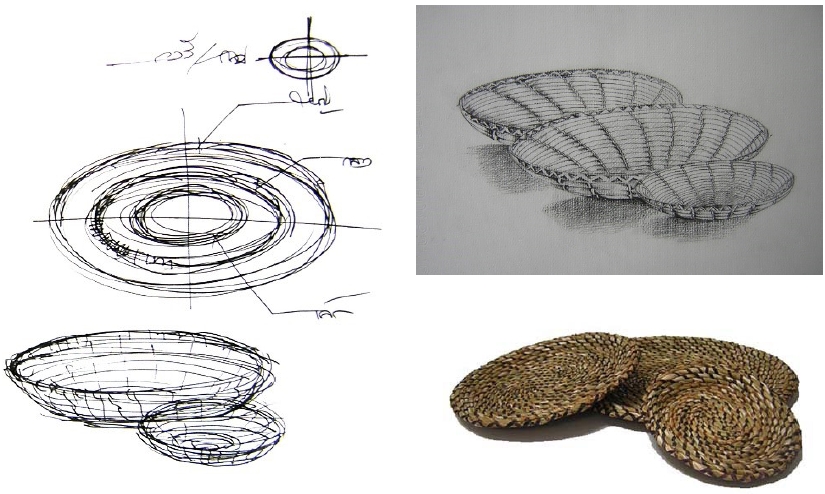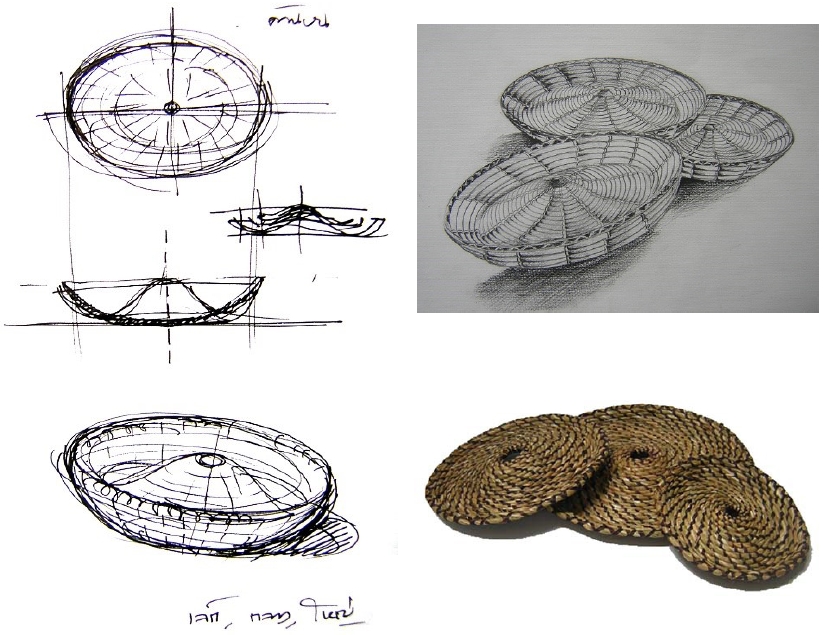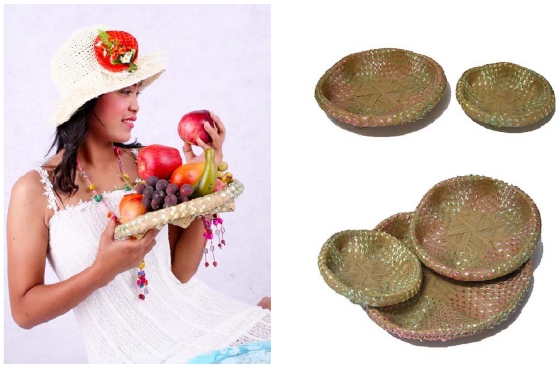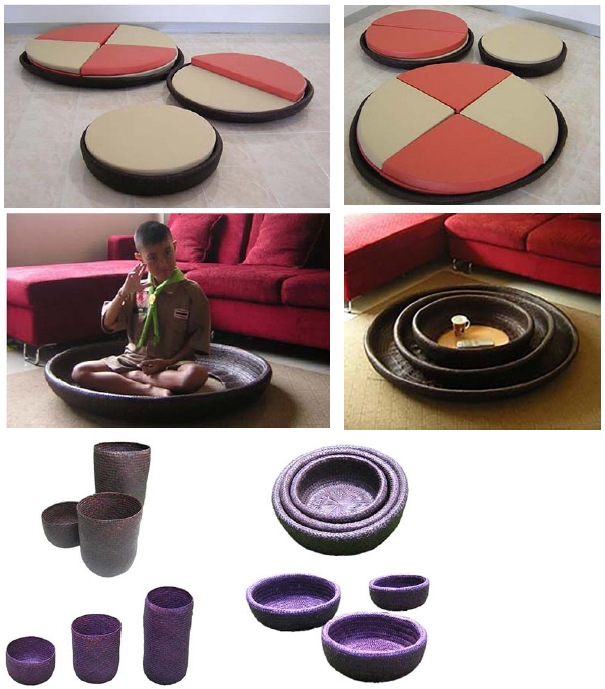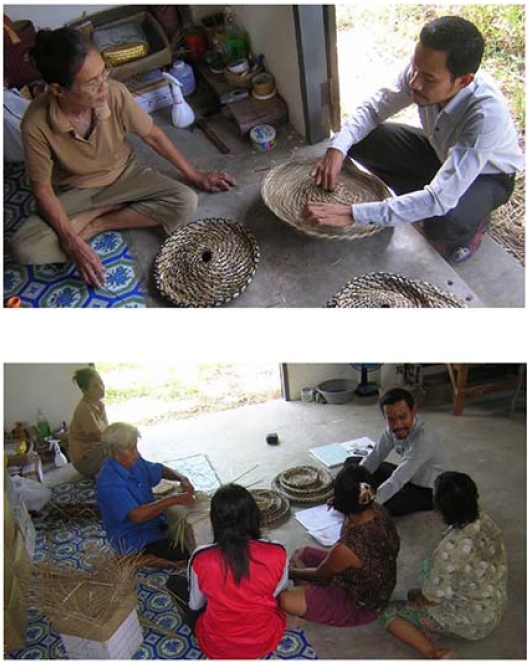
Design and Technology Transfer to Social Community on the Seagrass (Krajood) Wicker Products in Thailand
Abstract
Background This study aims to investigate the needs of Krajood wicker products in Nakhon Si Thammarat, Thailand. Krajood wicker products were deliberately designed and developed based on the design technologies through the participation of the community.
Methods Data were collected using questionnaires, which investigate the needs of consumers, identify potentially feasible styles before applying the design technologies, and create product prototypes in collaboration with the community.
Results The study revealed that women constituted the largest group participating in the project. They actively engaged in designing and developing the products in three material-based categories: 1) the design incorporating materials acquired easily, namely local banana plant fiber; 2) the design incorporating synthetic materials, namely plastic ropes; and 3) the design using 100% Krajood.
Conclusions The products designed based on local wisdom maximized the value of community-generated ideas, which can be observed in the innovative prototypes of containers and home decorations. The developed Krajood wicker demonstrated innovation as it is a combination of local materials, versatility, and utility. The researcher also acknowledged the importance of training, which helped the locals improve their traditional craft skills as well as earn more financial income.
Keywords:
Design, Technology Transfer, Social Community, Krajood, Wicker Product1. Introduction
1. 1. History and importance of the problem
The handicrafts in each locality manifest beauty, and they represent the community’s identities. They also represent the local wisdom and knowledge from the local community, which can be handed down to the next generations. Initially, handicrafts were only used within the household. However, their use has been extended in some communities as a result of a higher demand for tourism, which impacts to the country’s economy. In large societies, connections were developed among localities for a greater production scale and the improvement of sales (Leesuwan,1989). Artistic crafts exclusive to the areas are shared with others from either the same or different artistic roots. In addition, newly created products are usually characterized by integrated features complying with the demands of the market.
In Thailand, industrial craft products play a significant role in the country’s economy and society as it helps people create jobs, increase employment rates, optimize the use of natural resources, conserve Thai handicrafts, and contribute to the country’s tremendous annual income. Over the period of economic recession, “Thailand’s industrial craft products” have proved themselves to have inherent strengths acquired from integration between local wisdom and cultures. Such combination lays a solid ground for works equipped with beauty, values, and identities portraying the Thai nation (Department of Industrial promotion, 2014).
According to anthropologists, early humans must have regularly cropped basketry plants, particularly for edible plants, and burned woodlands to encourage their growth (Anderson, 1999). Thus, wicker remains the most versatile technique since the weaving is flexible but sturdy. In fact, it is used for fences, walls, furniture, animal traps, and many other advanced shapes (Gabriel and Sally, 1999).
The southern part of Thailand has been a stronghold for wicker handicraft manufacture for so long that both the region and the product itself have also gained recognition for its value, beauty, versatility, and utility. Infact, several natural wicker materials communicated the uniqueness of the locality, such as Toey Panan, Lygodium (Yan Lipao), and the Seagrass (Krajood). Furthermore, the Krajood wicker product is listed as a marked product in the One Tambon One Product project (OTOP) in the Appliance and Decoration category in Nakhon si Thammarat (The Industry office, Nakhon Si Thammarat, 2010). Its reputation spreads across Thailand from its significant production site in Khreng sub-district, Cha-Uat district Nakhon Si Thammarat, where the locals in almost every household have expertise in creating Krajood handicrafts. However, the locals nowadays only do Krajood handicrafts as their part-time job. In other words, the making of Krajood handcraft is only pursued when villagers are free from their full-time jobs within the community (P. Kongkuea, personal communication, April 18, 2015). In a southern dialect, the activity is referred to as “Sad Jood” meaning the making of a Krajood wicker. Generally, the popularity of Krajood wicker also derives from its simple steps to make as well as consumers’ demands for Krajood’s home decorations made from Krajood.
Typical among the locals is the complacency and contentment in life and decent income for a living to the degree in which enthusiasm in initiating ideas or creating new products was barely fueled. Such a particular mindset seemed to be prevalent in the Khreng community in Cha-Uat district, Nakhon Si Thammarat. The primary survey revealed no record of innovative Krajood wicker products due to the villagers’ satisfaction with their income generated from the products, which are easy to make and sell. However, competition among sellers in the community to obtain large customer orders surfaced, trivializing the quality and value of conveying unique identities and local characteristics. Such a competition opens a new opportunity for the locals to innovate and introduce new product designs. The variety of the products on the market both from the nearby communities and within the same category of handicraft products appeal to prospective customers’ needs and structured directions concerning types of products and their target groups.
In the fields of both design studies (Cross, 2001) and innovation (Paulus et al., 2012), various forms of collaboration are brought into focus. The first and most apparent version of “together” in design and innovation processes focuses on the social aspect. It is about the collaboration between designers, innovators, users, and various stakeholders. The underlying assumption of this aspect of collaboration and cooperation is to introduce the diversity of perspectives. Consequently, such approaches try to achieve interdisciplinarity, multiperspective, and emergent effects that cannot be brought about by a single designer only. User-centered design or co-design approaches are examples of such collaborative processes.
Overall, it can be seen that the significance of developing characteristics of design cannot be overstated since it is the factor attracting customers to demand something different from other industrial craft products. Therefore, this study intends to investigate the design and development of Krajood wicker products for tourism and home decoration. The data collected would serve as a guideline to design and develop theories on utilization and artistic beauty to increase and promote sales and value for the products. Furthermore, positivity is also expected in the promotion and development of an array of innovative products as stated in the policy of the Department of Industry Promotion, Department of Export Promotion, and other involving units. Exchanging ideas and working on designs with the social community is also considered because the social design is involved, directly and indirectly, in social problems related to design (Won, 2020). All in all, the exchange of cumulative knowledge on the craft and close collaboration within the community ultimately leads to designing and developing local products encompassing suitability and characteristics. This is one remarkable way to conserve Thai wisdom and instill distinctive value in the province’s handicraft product so that it is accepted by consumers and target groups both nationally and internationally.
1. 2. Research objectives
1. To investigate the needs of consumers and those interested in Krajood wicker products in Nakhon Si Thammarat, Thailand
2. To design and develop Krajood wicker products
3. To pass on knowledge on the technology for Krajood wicker product design using participatory action with the community
1. 3. Expected outcomes
1. To gain an insight into the needs of the consumers and those interested in Krajood wicker products in Nakhon Si Thammarat to further develop the design
2. To design and develop Krajood wicker products relevant to consumers' demands and those interested in the product.
3. To transfer the technology for Krajood wicker product design through participatory action with the community
1. 4. Research scope
1. Needs of the consumers and those interested in Krajood wicker products in Nakhon Sri Thammarat, Thailand
2. Design and develop Krajood wicker products and create five Krajood wicker product models
3. Transfer technological knowledge of Krajood wicker product design
2. Methodology, study process and propagation of technological knowledge
2. 1. Research methodology
The researcher investigated the context of Ban Nai Kuan community in Khreng sub-district, Cha-Uat district, Nakhon Si Thammarat. The primary data used to design Krajood wicker products were collected from field observations and interviews focusing on characteristics of Krajood and production processes from local scholars in the community.
The instruments employed in the data collection stage included questionnaire designed by the researcher, which focused on consumer’s needs and individuals interested in the Krajood wicker products and tourists. The questionnaire was distributed to a total of 100 informants around the province’s marked tourist attractions such as Pramahatat Woramahaviharn, souvenir shops. The questionnaire’s topics inquired about utility and aesthetics.
Data collection
The data were collected using field investigation, gaining an insight into consumers’ needs and those interested in Krajood wicker products through questionnaires and interviews. The data collected served as a primary data, which was utilized in the development of the models. Interviews directed toward consumer’s needs were conducted with five experienced manufacturers in Khreng sub-district, Cha-Uat district, Nakhon Si Thammarat, and ten souvenir shop entrepreneurs to provide a clear path for the model design and development.
The process of transferring design technologies
Fifteen manufacturers were gathered to directly learn the fundamental technologies in design from experts and the researcher through participation. The knowledge acquired would then be integrated with data on the consumer’s needs initially obtained. After that, training for model development was arranged. After the design and development of the model that had been carried out and concluded under the supervision of the experts, the derived knowledge would then be passed on to the community.
During the training and activities, participants were encouraged to constantly participate in sharing ideas and approaches in designing Krajood wicker products. The purpose of which was to assess both the feasibility and the suitability of the products. Lastly, the results of the design and development of the Krajood wicker product project were concluded by presenting the complete product to the public.
2. 2. Propagation of technologies
In terms of technology transfer, the research team conducted the training, which was attended by the representatives of the manufacturer group in Ban Nai Kuan community, Khreng sub-district, Cha-Uat district, Nakhon Si Thammarat. The training on fundamental design technologies was supervised by experts and the researcher using a participatory action method, allowing participants to share and discuss problems, consumers’ needs, and directions for model development. In addition, such training serves as a guideline for Krajood wicker product design to be customized according to the participants' ideas, leading to sustainable development. The design technology training was divided into four steps and was carried out as specified in the steps below.
1. Organize a seminar and have everyone involved informed about the project’s directions and product development.
2. Create prototypes of the Krajood wicker products together with the community’s representatives
3. Pass on the knowledge earlier acquired on design and development of Krajood wicker products through three training sessions
4. Conclude the project’s outcome
3. Result
Part 1 Context of Krajood wicker products, Ban Nai Kuan community, Khreng sub-district, Cha-Uat district, Nakhon Si Thammarat
1. Preparing Krajood to make wicker products:
Research suggests that the Krajood manufacturing process commences with raw material preparation from harvesting fresh fully-grown Krajood, approximately maturing in its year 2 or 3. Specifically for the uprooting, an adequately dense bunch of Krajood’s top ends are firmly grasped and then pulled from the ground. Fresh Krajood is sorted into sizes and then thoroughly kneaded with mud. After that, the Krajood bunch is soaked in the mud or sandy clay dissolved water. At this stage, Krajood will have been covered with a thin layer of particles preventing it from shriveling or being fragile when dried out in the sun. It also helps to add a pearly white color to Krajood after the sundry step as well. It takes only 2 or 3 days for Krajood to dry out. The dried-out Krajood will be smashed or motored until it is flat with intense sunlight. This can be either done manually using a pestle or mechanically using a roller which effectively shortens the time and saves manual labor. Smashed flat Krajood is rinsed with water for the dying process to eliminate small clay particles sticking to the outer skin before dipped into a bucket containing boiled dye water. After “Tok Krajood” dry flat Krajood reeds) have absorbed coloring water, it will then be rinsed off with water one more time and finally dried out in the sun.
2. The manufacturing process of Krajood wicker product
Originally, wicker patterns were not much diverse. The most common of which was called “Lai Song” (Pattern two). This pattern is usually seen in a few actual traditional products i.g., mats, sleeping bags. Krajood wicker methods vary depending on the product’s type and character. Both males and females were found to do wicker, but most were women aged 12 to 13 and elderly aged 70 years. On average, wicker manufacturers were females aged 20 to 60, undertaking the task as the primary labor source. In terms of time and places, it was found that most villagers pursued wicker-making during the daytime after having completed their daily obligations. Villagers are usually seen making wicker inside their houses or outside either on a porch or around their houses and sitting crouched one knee or the other as preferred, or simply sitting with legs crossed.
3. Assembling parts to make a complete product
At this stage, Krajood wicker sheets were cut into several different parts according to the forms and types of each product, except for those products conveniently woven into a complete piece of product such as a basket, a mat, etc. At the pre-assembling stage, parts may be coated with varnish polyurethane or lacquer to provide a durable seal against insects and maintain the product’s original shapes. Nevertheless, lacquer coating can be skipped to keep the products’ natural looks as preferred by some customers.
4. Types and utility of products
- For a Krajood mat, commonly known among southerners as “Sad Jood”, the survey revealed that the locals adopted a standard weave pattern, namely Two Plain Weave in Khreng sub-district, Cha-Uat district, Nakhon Si Thammarat since it is not time-consuming and highly demanded home decoration pieces among customers.
- Sack: an all-purpose sack portrays ancestors’ wisdom passed on for generations
-There were units for industry promotion and population’s occupation development, and government officers were in charge of advising on manufacturing methods and ideas about patterns and forms best corresponding with the new generation’s needs to expand the market.
Part 2: Needs of consumers and those interested in Krajood wicker products in Nakhon Si Thammarat
Most consumers and those interested in Krajood wicker products were females (70%) and males (30%). For the age range, they were divided into the 31-40 (26%,) the 21-30 range (22%), the 41-50 range (20 %), those under 20 (16%), the 51-60 range (14%) and those over 60 (2%). Seventy-seven percent of the participants resided in Nakhon Si Thammarat, which accounted for 77%. The most common Krajood wicker product on the market is a Krajood mat (a Seagrass mat), accounting for 69%. Criteria for Krajood wicker products immensely emphasized utility at 27.54%. Opinions concerning guidelines for design and development of Krajood wicker products highlighted the design corresponding with locally available natural materials at 68 %, and most selected material was banana tree fibers at 42%, and design incorporating the use of synthetic materials accounted for 17%. In terms of the synthetic materials, 10% leaned toward ropes, while 15% was committed to the sole use of Krajood. Lastly, the most selected products for collaborative design and development were a container at 26 %.
Part 3: Design and development of Krajood wicker products
The analysis of the needs of both consumers and those interested in Krajood handicraft products, focusing on the product’s design and development, revealed tangible guidelines enunciating an integration of Krajood with local natural materials, namely banana tree fibers. The combination should add unique characteristics to the product, resulting in higher demands among prospective consumers. Therefore, further development should be prioritized and experimented with a synthetic material, namely a rope. Within this context, plastic ropes, a locally common material available at a convenience store, received much interest because of the feasibility regarding material sourcing and product variety meeting consumers’ diverse demands. In terms of the product type, a woven container for household’s all-purpose usage i.g., a basket, a tray etc. For a wicker style, the team experimented with weaving a wicker chair pad sole made of Krajood, one type of which would come with a leather cushion and one without it because there was one particular group of consumers reiterating Krajood’s inherent potential to create beauty without integration with being woven or mixed with other materials.
Part 4: Passing on technologies for Krajood wicker product design through participatory action with the community
Only some members of the Nai Kuan community in Khreng sub-district, Cha-Uat district, Nakhon Si Thammarat engaged in passing on technologies for Krajood wicker product design, comprising an interview and discussion on needs of manufacturer representatives and the experimental making of the product prototypes. Such partial participation resulted from the community’s context in that a substantial share of time had to be allocated to earn a living, thereby causing relatively little interest in innovating the Krajood wicker products. Therefore, the research team searched for particular interest groups in advancing the product’s design and manufacturing it using the same materials and finally found Ban Lam community in Hua Sai district, Nakhon Si Thammarat. A group was formed to develop wicker products using other natural materials such as Toddy palm fibers, Vetiver grass, etc.
4. Conclusion
Part 1: Context of the Krajood Product Manufacture in Ban Nai Kuan community, Khreng sub-district, Cha-Uat district, Nakhon Si Thammarat
In terms of the context of Krajood wicker products manufactured in Ban Nai Kuan community, Khreng sub-district, Cha-Uat district, Nakhon Si Thammarat, it has been concluded that the manufacturing process, starting from the Krajood uprooting step to the making of Krajood reeds ready for wicker, comprises a number of deliberate and complex steps which limit the number of artisans with Krajood manufacturing expertise. Also, the general designs of the product itself barely communicated a sense of uniqueness but instead strong similarities throughout the community. This denotes a lack of community product’s identity. However, the making of Krajood wicker products could still be seen due to the villagers’ needs for income made out of them.
Part 2: Needs of consumers and those interested in Krajood wicker products in Nakhon Si Thammarat
The consumers expressed their demand for distinctive and new product designs by having Krajood reeds woven with other useable materials mainly because Krajood products are dominantly available on the market, namely Krajood mat (Sad) and sack as well as the Two Plain Weave pattern, which is becoming less attractive. Potential materials for a balanced combination with other natural materials include banana tree fibers and Yan Lipao. However, for the Yan Lipao, experimental manufacture suggested an infeasible combination with Krajood fibers due to their significant difference in fiber’s sizes causing unfit weaving. Consumers leaned toward a plastic rope in terms of synthetic materials, which likewise resonated among the manufacturers judging based on uniqueness possibly yielded. Additionally, given that the market well perceived such integrated design, plastic ropes would be practically easy to come by. Finally, the research team pursued the commination of Krajood and plastic ropes, and the results encouraged further potential for further development.
Part 3: Design and development of Krajood wicker products
Krajood wicker containers were pursued because of their various benefits and consumers’ preference towards the utility of the products. As a result, other factors play a relatively less important role in a purchase decision. In addition, Krajood wicker containers presented their versatility by functioning either as a container or simply even as a home decoration.
Part 4: Passing on technologies for Krajood wicker through participatory action with the community
The community’s enthusiasm for product design innovation was at its minimum. Similarly, responses to the training and actions carried out required improvement and more engagement as well. Accordingly, projects convincing the community through its instant potential benefits of earnings and income.
Acknowledgments
This research project would not have been successful without close cooperation from Ms. Aum-Nuay Rattana and members of Ban Nai Kuan community, Khreng sub-district, Cha-Uat district, Nakhon Si Thammarat, Khun Aum-Nuay Boonin and Ban Lam community, Hua Sai district, Nakhon Si Thammarat, participating handicraft shops in Nakhon Si Thammarat and all the questionnaire respondents for the beneficial data. We would also like to thank the Committee of Research Network and Transfer of Technologies to Community, Office of the Higher Education Commission (OHEC) of Upper southern region, Institute of Research and Innovation, Walailak University and the team members. We would like to extend our deepest gratitude to the Committee of Research Network and Transfer of Technologies to Community, Office of the Higher Education Commission (OHEC) of Upper southern region for providing for the research fund. Lastly, we would like to thank all the supporters for their support and help in all aspects and also friends and other faithful collaborators, whose names may not be stated here but their support is by all means well recognized, for this accomplishment.
Notes
Copyright : This is an Open Access article distributed under the terms of the Creative Commons Attribution Non-Commercial License (http://creativecommons.org/licenses/by-nc/3.0/), which permits unrestricted educational and non-commercial use, provided the original work is properly cited.
References
-
Anderson, M. K. (1999). The fire, pruning and coppice management of temperate ecosystems for basketry material by Californian Indian tribes. Human Ecology, 27(I), 79-113.
[https://doi.org/10.1023/A:1018757317568]

-
Cross, N. (2001). Designerly ways of knowing: design discipline versus design science. Design Issues, 17(3), 49-55.
[https://doi.org/10.1162/074793601750357196]

- Department of Industrial promotion. (2014). Thai industrial crafts product. Bangkok : Ministry of Industrial.
- Gabriel, S., & Goymer, S. (1991). The complete book of basketry techniques. David & Charles.
- Leesuwan, W. (1989). Basketry in Thailand. Bangkok : O. A. Printing House.
-
Paulus, B. P., Dzindolet, M., Kohn, N. W. (2012). "Collaborative Creativity: Group Creativity and Team Innovation." In M. Mumford (Ed.), Handbook of Organizational Creativity. San Diego, CA: Academic Press.
[https://doi.org/10.1016/B978-0-12-374714-3.00014-8]

- The Industry office, Nakhon Si Thammarat. (2010). OTOP in Nakhon Si Thammarat. Bangkok : Ministry of Industrial.
-
Won, H. (2020). Designs for sensing radiation: deployment of a tangible interface and a visual projection interface for user interaction. Archives of Design Research, 33(2), 57-71.
[https://doi.org/10.15187/adr.2020.05.33.2.57]

